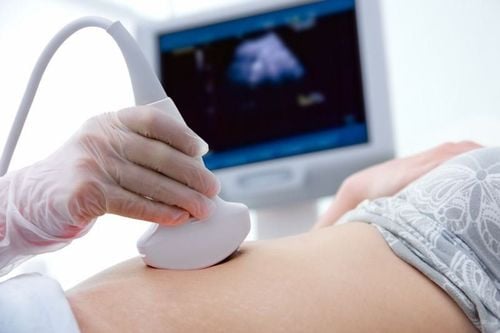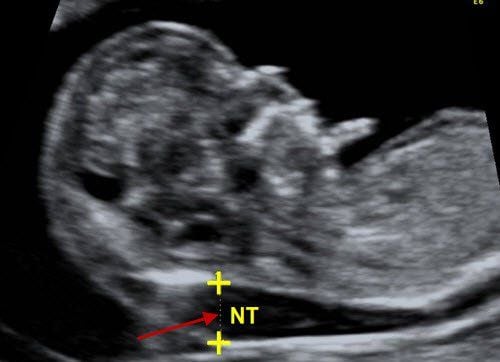This is an automatically translated article.
The article is professionally consulted by Master, Doctor Nguyen Thi Hong On - Department of Obstetrics and Gynecology - Vinmec Phu Quoc International General Hospital.Amniocentesis is a prenatal test in which a small amount of amniotic fluid is drawn from the uterus through the abdominal wall under ultrasound guidance. This amniotic fluid will be sent for genetic analysis, thereby helping to detect genetic disorders if any.
1. How is amniocentesis performed?
When on the procedure table, the pregnant woman will lie on her back, exposing the abdomen and being disinfected, covered with a sterile towel. Pregnant women will have amniocentesis under ultrasound guidance, because the ultrasound will identify areas with lots of amniotic fluid without fetal structures.Amniotic fluid will be drawn through the abdominal wall, through the muscle of the uterus with a very small needle inserted into the amniotic chamber. Normally, the amount of amniotic fluid that needs to be taken is 15 - 30 ml. This amniotic fluid sample will then be subjected to the necessary diagnostic tests. Amniocentesis is usually done in 5-10 minutes. The mother's body will regenerate the amount of amniotic fluid that has been removed and the baby will not be deficient in amniotic fluid after the test. When a woman is pregnant with twins (2 amniotic sacs in the uterus), it may be necessary to insert a needle twice into the uterus to collect amniotic fluid from two separate amniotic chambers.
Pregnant women will feel a bit of pain when the amniocentesis needle is inserted and a slight discomfort in the abdomen after a few hours, possibly due to psychological stress during the procedure. After amniocentesis, it is best for pregnant women to rest for 1 day, do not carry heavy objects, do not have intercourse, and then can resume normal activities. Amniocentesis results will be available within 2-3 weeks or sooner depending on the medical facility.
2. Amniocentesis what week of pregnancy is best?
Amniocentesis can be performed at 3 times:Early Amniocentesis: 13 to 16 weeks gestation. Classic amniocentesis: gestational age from 17 to 20 weeks. Late amniocentesis: after 20 weeks. The best gestational age for this amniocentesis is 17-18 weeks. Since this is the time when the chances of successful amniotomy are highest, the rate of complications for both mother and fetus is lowest.

Tuổi thai tốt nhất để thực hiện thủ thuật chọc ối này là 17 - 18 tuần tuổi
3. What is the effect of amniocentesis?
The purpose of amniocentesis is to determine if the fetus has certain genetic disorders or chromosomal abnormalities such as Down syndrome (3 chromosomes 21), Patau syndrome (3 chromosomes 13), and Edwards syndrome (3 chromosomes 18),...Amniocentesis can be performed in the last 3 months of pregnancy in cases where it is necessary to determine the maturity of the fetal lungs when it is necessary to terminate the pregnancy early due to medical conditions. as pre-eclampsia. Or it may be done to diagnose an infection of the amniotic fluid.
4. Which pregnant women should perform amniocentesis for prenatal screening?
Amniocentesis is only performed on high-risk pregnant women with certain genetic disorders such as:The results of triple test and combined test show a high risk of malformations. Thick nuchal translucency measurement. The noninvasive screening test (NIPT) shows a high risk of genetic disorders. Father and/or mother with certain genetic disorders (eg, thalassemia) History of having a baby with genetic birth defects Lips, cleft palate, heart defects, structural abnormalities in the kidneys, dilated ventricles... Before any prenatal screening test is done, pregnant women will be advised of the benefits as well as the risks. benefits of testing.

Phụ nữ mang thai có nguy cơ cao nên chọc ối để sàng lọc trước sinh
5. Risk of amniocentesis
Possible risks when performing amniocentesis:Amniotic infection, miscarriage. Amniotic fluid leak Fetal trauma Rh sensitivity (common in women with rare blood types) Vaginal bleeding and cramping. Some women will have mild abdominal pain after amniocentesis, pregnant women should rest on the day of amniocentesis, the next day the abdominal pain will decrease. In some cases, the doctor will give medication to take after amniocentesis to relieve pain.
The most important complication and risk of prenatal screening by taking a pregnancy sample is that it can cause miscarriage, rupture of membranes, and infection. According to recent studies for statistical results, the risk of miscarriage with amniocentesis is 1 in 500. This means that 1 out of every 500 women who have amniocentesis will have a miscarriage. However, when the mother has the following problems, there may be an increased risk of miscarriage, although there is no specific evidence for this association:
Uterine fibroids Uterine malformations The membranes have not merged membrane membrane. Hematoma under the choroid. Mother with history or recent bleeding Obesity (BMI > 40) [BMI: body mass index] Multiple births (>3 times) Having vaginitis History of >3 miscarriages.

Sàng lọc trước sinh để trẻ sinh ra khỏe mạnh
Please dial HOTLINE for more information or register for an appointment HERE. Download MyVinmec app to make appointments faster and to manage your bookings easily.













